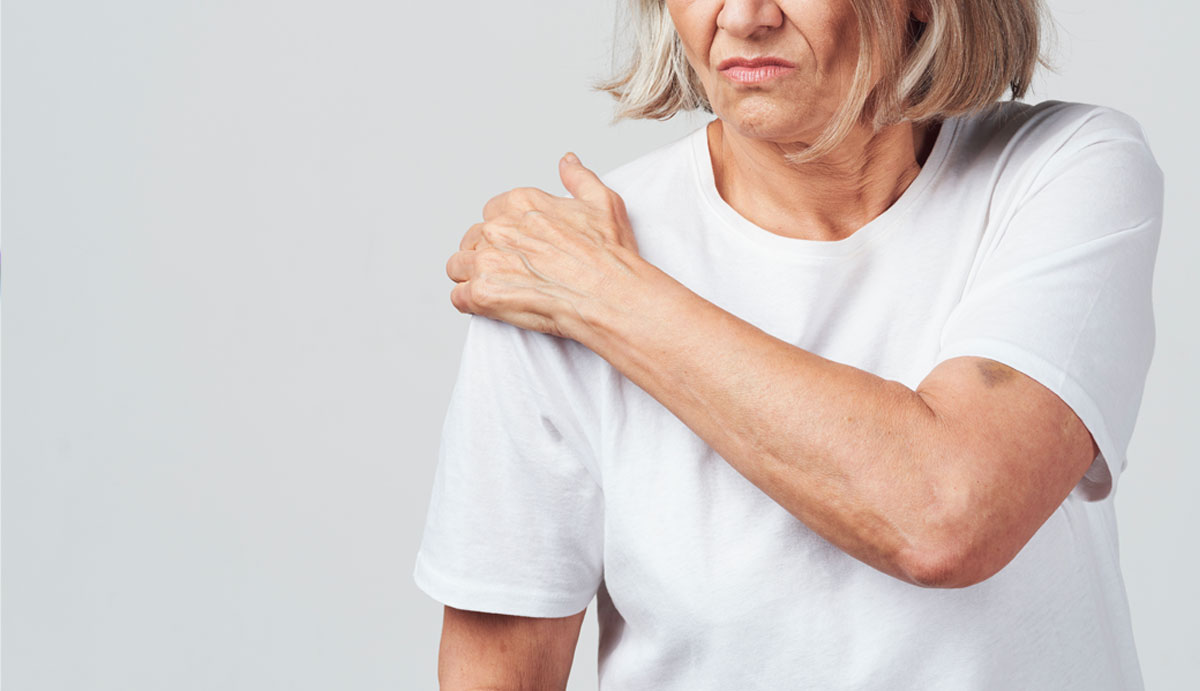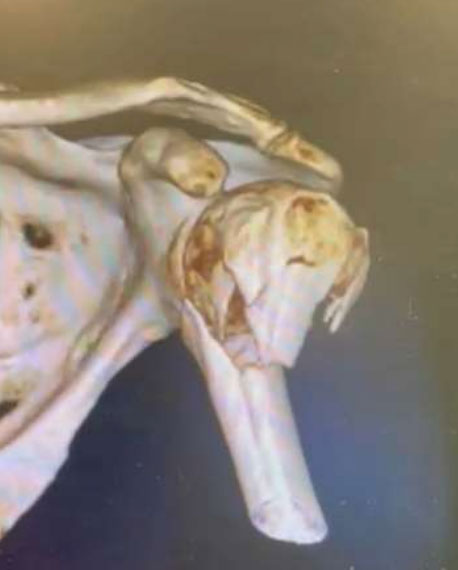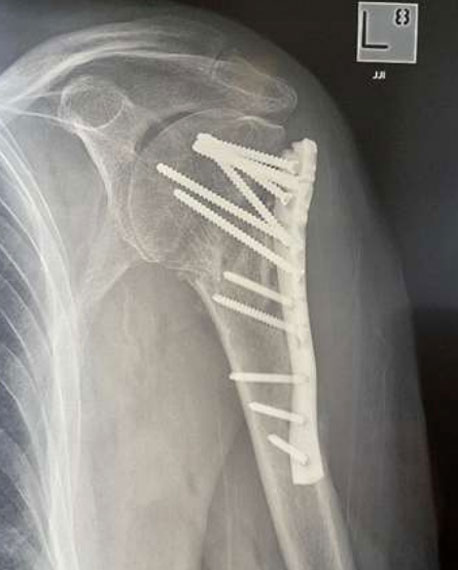Proximal Humerus Fracture Surgery

Most proximal humerus fractures are minimally displaced and can be treated non-operatively. Surgery may be necessary in displaced fractures.
- Dr Duckworth


Most proximal humerus fractures are minimally displaced and can be treated non-operatively. This involves use of a sling to immobilize the arm and later physical therapy to restore function.
Surgery may be necessary in displaced fractures. The multiple fragments are fixed with plates, screws, an intramedullary nail or occasionally a joint replacement.
Learn more about proximal humerus fractures
The procedure
How is the operation performed?
You are assessed by Dr Duckworth and if your fracture is displaced he will recommend surgery.
The operation is done under a general anaesthetic and the fracture is exposed by an incision at the front of your shoulder. The fracture fragments are then brought back into near anatomical position and then stabilized with a plate and screws put on the outside part of the bone, or by an intramedullary pin put on the inside of the bone. This then allows you to move your arm without the feeling of the bones grating.
After surgery, you are then put into a sling. However, we generally recommend you come out of the sling as quickly as possible and start using your arm within your pain limits. The sooner you start moving your arm the quicker you will regain function.
The majority of patients wake up saying their arm feels so much more comfortable.
What happens on the day of the operation?
When the staff at the rooms book you in for surgery, they will give you an approximate guide of when you must fast and present at the hospital. The hospital will contact you a day or two before the surgery to finalise the arrangements.
Once admitted, you will be visited by your anaesthetist who will ask questions about your health and talk to you about the anaesthetic he will give you. He will also use this time to talk to you about pain relief after the operation.
If necessary, your shoulder may be shaved or the hair clipped and the area "prepped" with betadine and covered with a sterile towel. When asked to change into a theatre gown, please remove all clothing. Underwear can be worn but the fabric must be a natural fibre and not synthetic.
Once in the operating suite, the anaesthetic nurse will place ECG electrodes (stickers with gel on them) on your chest and a blood pressure cuff on your arm.
The anaesthetic is administered through a small needle in the back of the hand/arm. This sends you to sleep quickly.
The operation itself takes 1-2 hours, however you will probably be away from the ward for about three hours as there is usually a short wait before the surgery, and then when the operation is over you will be cared for in the recovery room for some time before returning to the ward.
Return to the ward after your operation
In the recovery room, a nurse will be there at all times. You will have a drip in your arm, an oxygen mask over your face or an oxygen tube in your nose. You will remain in the recovery room until the staff is satisfied that your condition is stable and your pain is controlled. This is usually about an hour.
What happens during the rest of my hospital stay?
The hospital staff will give you regular pain relief, which is important to keep your pain at a tolerable level to enable you to move about and exercise. The codeine in some tablets can make you constipated however it is wiser to avoid or treat the constipation rather than going without the pain relief. This can be done by drinking at least 8 glasses of water or juice per day (tea and coffee do not count), eating a high-fibre diet including fresh fruit and vegetables each day and walking around rather than confining yourself completely to bed. Mild laxatives are available should you feel you need them. Once you, Dr Duckworth and the staff are satisfied that you are comfortable and well enough to be discharged you will be able to go home.
What can I expect at home?
Dr Duckworth's nurse, Rebecca, will phone you within a couple of days of coming home. While the main purpose of her call is to check that all is going well, this is also an opportunity to ask any questions and also to confirm or make your follow-up appointment to have your wound checked.
For those patients who come from the country, it may be more convenient to have your wound checked by your local doctor.
After your operation
Pain
You will still have some pain but this should be relieved by the tablets you are discharged home with. You will need to take these regularly for the first week and then decrease them as the pain improves. You may find your pain is quite bearable if you take pain relief regularly. Please advise Dr Duckworth's team, if your pain is not adequately managed or if it suddenly becomes worse or severe.
Wound Care
You will be discharged home with a dressing protecting your wound and you should not need to change or remove it. These dressings are waterproof, enabling you to shower and wash without worrying about wetting it. You may see some blood beneath the dressing but this will not cause any harm and can remain as is until you are seen about one week after your operation. If this dressing should come off do not worry, you can still get the wound wet but just be sure to rinse off any soap or shampoo and pat the area thoroughly dry.
Showering / Washing / Bathing
We do not recommend soaking in a bath until your wound has healed completely. You may take your sling off and shower, however, you will possibly need some assistance with showering until you become more confident.
The sling
Your arm is rested in a sling while it heals, however we usually recommend coming out of it as soon as possible to enable you to gradually start to use your arm again. It is recommended that you wear the sling when leaving your home.
Follow-up visits
You will see Dr Duckworth when your wound is checked 5-10 days after your surgery and then further follow-up will be determined by him depending on your rate of progress.
Driving a car
Driving with two hands is allowed as soon as you have movement and control of the operated arm (about 2-4 weeks).
Driving with one arm in a sling is NOT recommended. We recommend you check with the RMS regarding the legalities re requirements for driving while your arm is in a sling.
Returning to work
Patients can usually return to office work as soon as they are comfortable. You should be able to perform table/desk level duties after a week or so. You should not weight bear through your arm for 6 weeks following the surgery.
It usually takes about 8-10 weeks before you can do light manual tasks and about 12-14 weeks before you can do heavy duties.
Sport
You cannot return to contact sports until your shoulder has been reassessed 3-4 months after surgery, and then only if you have excellent strength and coordinated control of your elbow.
Physiotherapy / exercises
Physiotherapy may be necessary after 6 weeks and Dr Duckworth will advise if this applies to you. Gentle, early mobilisation of the affected arm is encouraged but let pain be your guide i.e. if you attempt to do something and it creates pain, don't do it!
For specific advice regarding proximal humerus fracture surgery, please book an appointment with Dr David Duckworth on (02) 9806 3333
For appointments and enquiries, please phone (02) 9806 3333
8am to 5pm, Monday to Friday
© 2008-2024 Dr David Duckworth